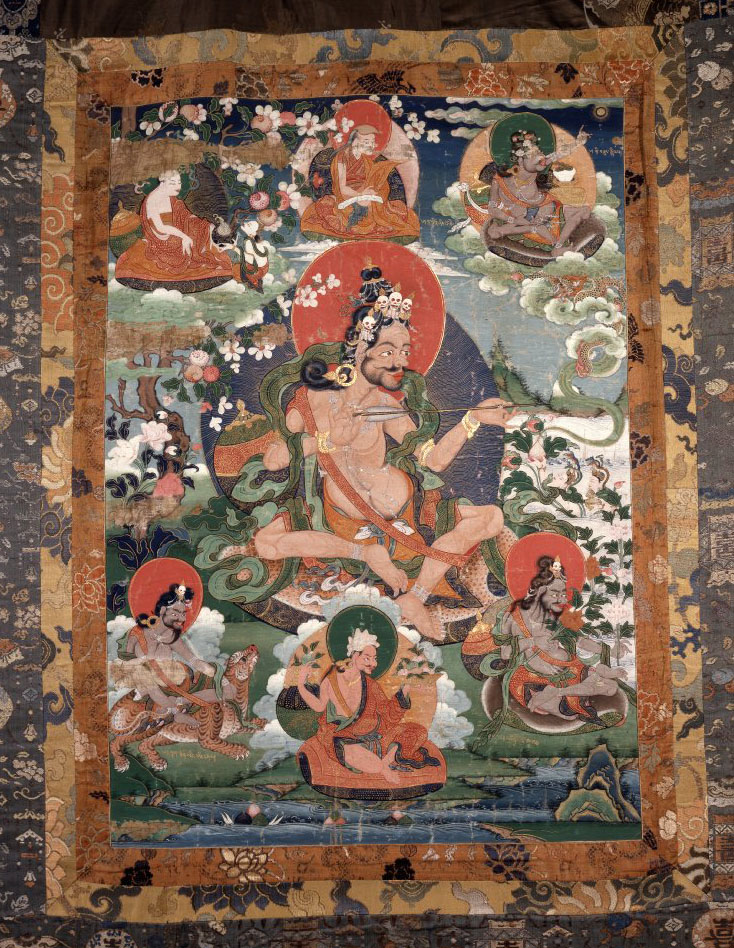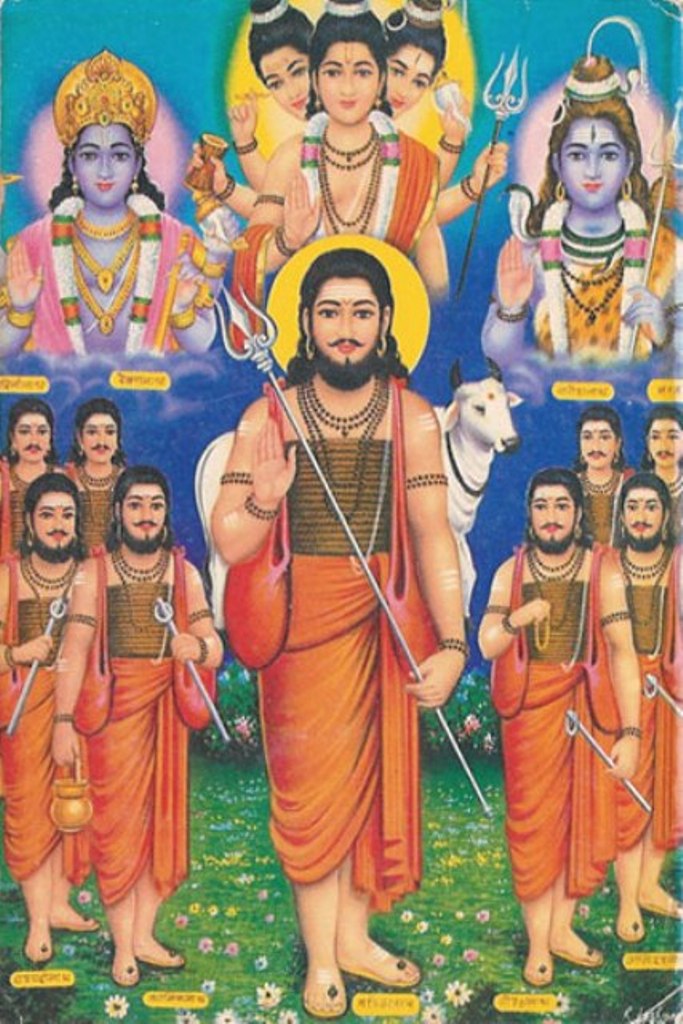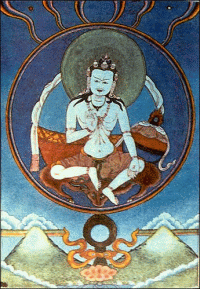|
Samarasa
Samarasa (Sanskrit Devanagari: समरास; IAST: samarāsa; synonymous with IAST: ekarāsa; ; ) is literally "one-taste" "one-flavour" or "same-taste" and means equipoise in feelings, non-discriminating or the mind at rest. Dzogchen Vajranatha (1996: p. 332) in his glossary of ''The Golden Letters'', an annexure to his translation of, and commentary upon, the 'Three Statements' () of Garab Dorje, defines thus: ro-gcig single taste, single flavour, the state of being a single taste, ekarasa ro-snyoms same taste, the process of making everything into the same taste, samarasa Buddhadharma Nalanda Translation Committee (1982: p. 223) render a work on Marpa, the famed Tibetan Yogi and define samarasa thus: "...equal taste (S: samarasa; T: ro-mnyam) The yogic practices and visualization exercises of Buddhist tantra are extremely complex, but underlying them is a single experience of things as they are. This realization or state of mind is sometimes called equal taste, ... [...More Info...] [...Related Items...] OR: [Wikipedia] [Google] [Baidu] |
Nath
Nath, also called Natha, are a Shaiva sub-tradition within Hinduism in India and Nepal. A medieval movement, it combined ideas from Buddhism, Shaivism and Yoga traditions in India.Natha: Indian religious sect Encyclopedia Britannica (2007) The Naths have been a confederation of devotees who consider , as their first lord or , with varying lists of additional gurus. Of these, the 9th or 10th century |
Sahaja
Sahaja ( pra, সহজ sa, सहज ) means spontaneous enlightenment in Indian and Tibetan Buddhist spirituality. Sahaja practices first arose in Bengal during the 8th century among yogis called Sahajiya siddhas. Ananda Coomaraswamy describes its significance as "the last achievement of all thought", and "a recognition of the identity of spirit and matter, subject and object", continuing "There is then no sacred or profane, spiritual or sensual, but everything that lives is pure and void." Etymology The Sanskrit nd the Tibetan, which precisely follows itliterally means: 'born or produced together or at the same time as. Congenital, innate, hereditary, original, natural (...by birth, by nature, naturally...)'. Etymologically, means 'together with', and derives from the root , meaning 'to be born, produced, to occur, to happen'. The Tibetan is an exact etymological equivalent of the Sanskrit. means 'together with', and means 'to be born, to arise, to come about, to be ... [...More Info...] [...Related Items...] OR: [Wikipedia] [Google] [Baidu] |
Natha
Nath, also called Natha, are a Shaiva sub-tradition within Hinduism in India and Nepal. A medieval movement, it combined ideas from Buddhism, Shaivism and Yoga traditions in India.Natha: Indian religious sect Encyclopedia Britannica (2007) The Naths have been a confederation of devotees who consider , as their first lord or , with varying lists of additional gurus. Of these, the 9th or 10th century |
Samādhi
''Samadhi'' (Pali and sa, समाधि), in Buddhism, Hinduism, Jainism, Sikhism and yogic schools, is a state of meditation, meditative consciousness. In Buddhism, it is the last of the eight elements of the Noble Eightfold Path. In the Ashtanga (eight limbs of yoga), Ashtanga Yoga tradition, it is the eighth and final limb identified in the ''Yoga Sutras of Patanjali, Yoga Sutras'' of Patanjali. In the oldest Buddhist sutra, suttas, on which several contemporary western Theravada teachers rely, it refers to the development of an investigative and luminous mind which is Upekkha, equanimous and mindful. In the yogic traditions, and the Buddhist commentarial tradition on which the Burmese Vipassana movement and the Thai Forest Tradition, Thai Forest tradition rely, it is interpreted as a meditative absorption or trance, attained by the practice of ''Dhyāna in Buddhism, dhyāna''. Definitions ''Samadhi'' may refer to a broad range of states. A common understanding regards ... [...More Info...] [...Related Items...] OR: [Wikipedia] [Google] [Baidu] |
Sanskrit
Sanskrit (; attributively , ; nominally , , ) is a classical language belonging to the Indo-Aryan branch of the Indo-European languages. It arose in South Asia after its predecessor languages had diffused there from the northwest in the late Bronze Age. Sanskrit is the sacred language of Hinduism, the language of classical Hindu philosophy, and of historical texts of Buddhism and Jainism. It was a link language in ancient and medieval South Asia, and upon transmission of Hindu and Buddhist culture to Southeast Asia, East Asia and Central Asia in the early medieval era, it became a language of religion and high culture, and of the political elites in some of these regions. As a result, Sanskrit had a lasting impact on the languages of South Asia, Southeast Asia and East Asia, especially in their formal and learned vocabularies. Sanskrit generally connotes several Old Indo-Aryan language varieties. The most archaic of these is the Vedic Sanskrit found in the Rig Veda, a colle ... [...More Info...] [...Related Items...] OR: [Wikipedia] [Google] [Baidu] |
Devanagari
Devanagari ( ; , , Sanskrit pronunciation: ), also called Nagari (),Kathleen Kuiper (2010), The Culture of India, New York: The Rosen Publishing Group, , page 83 is a left-to-right abugida (a type of segmental Writing systems#Segmental systems: alphabets, writing system), based on the ancient Brahmi script, ''Brāhmī'' script, used in the northern Indian subcontinent. It was developed and in regular use by the 7th century CE. The Devanagari script, composed of 47 primary characters, including 14 vowels and 33 consonants, is the fourth most widely List of writing systems by adoption, adopted writing system in the world, being used for over 120 languages.Devanagari (Nagari) , Script Features and Description, SIL International (2013), United States The orthography of this script reflects the pr ... [...More Info...] [...Related Items...] OR: [Wikipedia] [Google] [Baidu] |
IAST
The International Alphabet of Sanskrit Transliteration (IAST) is a transliteration scheme that allows the lossless romanisation of Indic scripts as employed by Sanskrit and related Indic languages. It is based on a scheme that emerged during the nineteenth century from suggestions by Charles Trevelyan, William Jones, Monier Monier-Williams and other scholars, and formalised by the Transliteration Committee of the Geneva Oriental Congress, in September 1894. IAST makes it possible for the reader to read the Indic text unambiguously, exactly as if it were in the original Indic script. It is this faithfulness to the original scripts that accounts for its continuing popularity amongst scholars. Usage Scholars commonly use IAST in publications that cite textual material in Sanskrit, Pāḷi and other classical Indian languages. IAST is also used for major e-text repositories such as SARIT, Muktabodha, GRETIL, and sanskritdocuments.org. The IAST scheme represents more than a ... [...More Info...] [...Related Items...] OR: [Wikipedia] [Google] [Baidu] |
Garab Dorje
Garab Dorje (c. 665) () was the first human to receive direct transmission teachings from Vajrasattva. Garab Dorje then became the teacher of the ''Ati Yoga'' (Tib. Dzogchen) or Great Perfection teachings according to Tibetan buddhist and Nyingma school traditions. The Tibetan Bon beliefs, which pre-date buddhism, differ in their origin story of Dzogchen. Etymology Garab Dorje (or Garap Dorje) is his only attested name. The Sanskrit offerings are reconstructions. No Sanskrit name has been found in a colophon. That said, John Myrdhin Reynolds cited Prahevajra or Pramodavajra in his book ''Self-Liberation Through Seeing with Naked Awareness'' ig pa ngo sprod gcer mthong rang grol Detail According to the Nyingma school of Tibetan Buddhism, Garab Dorje transmitted the complete empowerments of Dzogchen to Manjushrimitra, who was regarded as his chief disciple. Padmasambhava is also known to have received the transmission of the Dzogchen tantras directly from Garab Dorje. Garab Dorj ... [...More Info...] [...Related Items...] OR: [Wikipedia] [Google] [Baidu] |
Marpa Lotsawa
Marpa Lotsawa, Lotsāwa (, 1012–1097), sometimes known fully as Marpa Chökyi Lodrö (Wylie transliteration, Wylie: mar pa chos kyi blo gros) or commonly as Marpa the Translator (Marpa Lotsāwa), was a Tibetan Buddhism, Tibetan Buddhist teacher credited with the transmission of many Vajrayana teachings from India, including the teachings and lineages of Mahamudra. Due to this the Kagyu lineage, which he founded, is often called Marpa Kagyu in his honour.samye.orgThe Kagyu Lineage: the Tibetan Lineage Masters: Marpa the Translator/ref> Although some accounts relate that the Mahasiddha Naropa was the personal teacher of Marpa, other accounts suggest that Marpa held Naropa's lineage through intermediary disciples only. Either way, Marpa was a personal student of the Mahasiddha Maitripa and of the dakini Niguma. Biography Born as Marpa Chökyi Lodrö, in Lhodrak Chukhyer in the southern part of Tibet, to an affluent family, he began studying at a young age but was wild and untamed ... [...More Info...] [...Related Items...] OR: [Wikipedia] [Google] [Baidu] |
Yogi
A yogi is a practitioner of Yoga, including a sannyasin or practitioner of meditation in Indian religions.A. K. Banerjea (2014), ''Philosophy of Gorakhnath with Goraksha-Vacana-Sangraha'', Motilal Banarsidass, , pp. xxiii, 297-299, 331 The feminine form, sometimes used in English, is yogini. Yogi has since the 12th century CE also denoted members of the Nath siddha tradition of Hinduism, and in Hinduism, Buddhism and Jainism, a practitioner of tantra.Rita Gross (1993), ''Buddhism After Patriarchy'', SUNY Press, , pages 85–88 In Hindu mythology, the god Shiva and the goddess Parvati are depicted as an emblematic yogi–yogini pair. Etymology In Classical Sanskrit, the word ''yogi'' (Sanskrit: masc ', योगी; fem ') is derived from ''yogin'', which refers to a practitioner of yoga. ''Yogi'' is technically male, and ''yoginī'' is the term used for female practitioners. The two terms are still used with those meanings today, but the word ''yogi'' is also used ge ... [...More Info...] [...Related Items...] OR: [Wikipedia] [Google] [Baidu] |
Svecchachara
Svecchācāra (IAST; Sanskrit: स्वेच्छाचार) is an important concept in the Nath Sampradaya. 'Svecchācāra' means: acting as one likes, arbitrariness, acting without restraint. The word appears to be a combination of three Sanskrit words: ''sva'' (self), ''iccha'' (will), and ''cāra'' (deportment), essentially adding up to "behaving as one desires" or "in accordance with one's will (iccha)". John Woodroffe (1951: p. 440) associates it with notions of antinomianism and that it is evident in the Upanishads and Tantras: "Lastly, the doctrine that the illuminated knower of Brahman (Brahmajnani) is above both good (Dharma) and evil (Adharma) should be noted. Such a one is a Svechacari whose way is Svechacara or "do as you will". Similar doctrine and practices in Europe are there called Antinomianism. The doctrine is not peculiar to the Tantras. It is to be found in the Upanishads, and is in fact a very commonly held doctrine in India." Woodroffe (1951: pp.& ... [...More Info...] [...Related Items...] OR: [Wikipedia] [Google] [Baidu] |








